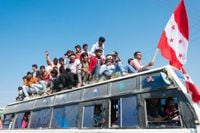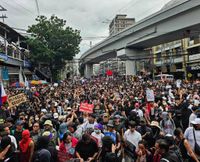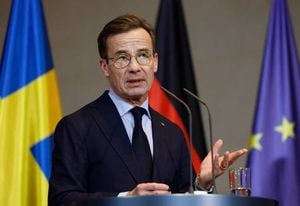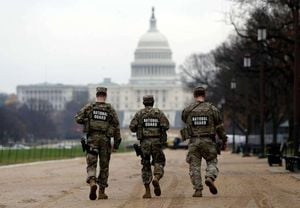As Nepal approaches its pivotal March 5, 2026 elections, the country finds itself at a crossroads, grappling with both immediate political turbulence and a deeper constitutional debate that could reshape its future. The atmosphere in the capital, Kathmandu, and beyond is thick with anticipation—yet also with apprehension, as powerful actors maneuver to protect their interests and frustrated citizens demand sweeping change.
In recent weeks, the political scene has been dominated by the controversial formation of the National Volunteer Force (NVF), a quasi-militant group announced by K.P. Sharma Oli, the former prime minister and current chair of the Communist Party of Nepal-United Marxist Leninist (CPN-UML). According to reporting by The Kathmandu Post, the NVF is widely seen not as a benevolent volunteer organization but as a force designed to serve Oli’s personal agenda—raising concerns about its potential to intimidate rivals and disrupt the fragile pre-election climate.
Oli’s motivations are under intense scrutiny. During the Gen Z protests that erupted in early September 2025, police under his premiership shot dead 19 protesters on the very first day. The protests, led largely by a new generation of activists, were a dramatic verdict on a political class seen as corrupt and out of touch. Oli has steadfastly refused to accept responsibility for the killings, rejecting the official probe committee established by interim prime minister Sushila Karki’s government. With his security detail drastically reduced by the Karki administration, and after being hurriedly evacuated by the army from the prime minister’s residence on September 9 to avoid a potentially violent mob, Oli’s sense of vulnerability appears to have fueled the NVF’s creation.
But Nepal’s political drama is not confined to Oli and the UML. The Nepali Congress, the largest party in the recently dissolved parliament, has officially committed to the upcoming elections, setting off a domino effect that is likely to push nearly 150 political parties—big and small, old and new—to register for the polls. As The Kathmandu Post notes, this surge in participation will make it increasingly difficult for the UML to stay on the sidelines, even as it hedges its bets amid uncertainty about the elections’ timing and fairness.
The stakes are high, and so are the stakes for Nepal’s international partners. India, in particular, is watching closely, concerned about the risk of instability spilling across the open border. Indian officials reportedly favor timely elections, seeing them as essential to maintaining order in the region. The international consensus, at least for now, seems to support Nepal’s democratic process—but with so many moving parts, nothing is guaranteed.
Security concerns are mounting. Clashes have already erupted between Gen Z activists and UML cadres, with fears that similar disruptions could mar other parties’ campaigns. The morale of the police force remains low after widespread arson and harassment during the September protests. Meanwhile, calls to include Nepali voters living abroad have grown louder, prompting an extension to the voter registration deadline. While these last-minute adjustments reflect the government’s responsiveness to public pressure, they also strain the Election Commission’s preparations, raising questions about whether the March 5 elections can proceed smoothly.
Amid this backdrop, a long-standing debate has resurfaced with renewed vigor: Should Nepal directly elect its chief executive? This question, which once divided the Constituent Assembly during the drafting of the 2015 constitution, is no longer just academic. The Gen Z uprising has breathed new life into the idea, with some of its leaders—most notably Miraj Dhungana and Amit Khanal—demanding a directly elected prime minister. Dhungana has even threatened to boycott the mid-term elections if this demand is ignored. Their argument is simple: after decades of unstable coalition governments, it’s time to let the people choose a leader who can serve a full, uninterrupted term.
But the idea is contentious. As The Kathmandu Post and Himal Southasian both report, Nepal’s 2015 constitution was the product of a hard-fought compromise. The Maoists, fresh off the battlefield, had championed a directly elected president, but were ultimately overruled by the Nepali Congress and various ethnic and regional groups who feared that majoritarian rule would sideline minorities and disrupt the delicate balance of power. The compromise established a parliamentary system with a ceremonial president and a prime minister chosen by parliament. Yet, the warning was clear: continued instability would inevitably revive calls for direct elections.
That prophecy has come to pass. Nepal has seen 16 governments in 17 years, with prime ministers rarely lasting more than a year. The infamous rotation of leaders—Deuba, Oli, Prachanda—has become a symbol of dysfunction, fueling public frustration and demands for change. The pro-direct-election camp, which includes Maoist factions, urban leaders like Kathmandu Mayor Balen Shah, and sections of the Gen Z movement, argues that a directly elected executive would bring stability, clear accountability, and faster decision-making. "If voters elect a leader directly, they know exactly whom to reward or punish," one advocate told Himal Southasian.
Yet critics warn of “dangerous simplicity.” A directly elected executive could concentrate power, risking authoritarianism. “If a directly elected executive makes grave mistakes, the nation must suffer for five years—because removing them becomes almost impossible,” a constitutional lawyer told Himal Southasian. Nepal’s complex social fabric—divided by ethnicity, region, and language—could be further strained by a winner-take-all system, with marginalized groups fearing permanent exclusion. There are also geopolitical risks: with Nepal sandwiched between India and China, a powerful executive could face intense external pressure, potentially destabilizing the region.
This debate is not just about political systems—it’s about the kind of nation Nepal aspires to be. The Gen Z movement, though united in its desire for change, is itself divided on the issue. Some factions, particularly from Madhesh and indigenous communities, caution that majoritarian rule could erase hard-won gains in inclusion and representation. Meanwhile, new political actors—like aviation mogul Birendra Basnet and energy minister Kulman Ghising—are forming parties that promise fresh ideas and faces, further complicating the electoral landscape.
Despite the uncertainty, there is a palpable sense of possibility. The Nepali Congress is on board with the elections, voter enthusiasm is high, and international support appears solid. Yet, as The Kathmandu Post cautions, with the UML still holding out and other potential spoilers waiting in the wings, much could still go awry before March. The return of the direct election debate reflects both the maturity and the fragility of Nepal’s democracy. As the country prepares to vote, it must confront tough questions about inclusion, accountability, and the balance of power—questions with no easy answers, but which will define Nepal’s path for years to come.
For now, all eyes are on Nepal. The coming months will test not only the resilience of its institutions but the depth of its democratic aspirations. Whether the nation opts for incremental reform or bold transformation, the choices made in this moment will echo far beyond the ballot box.





